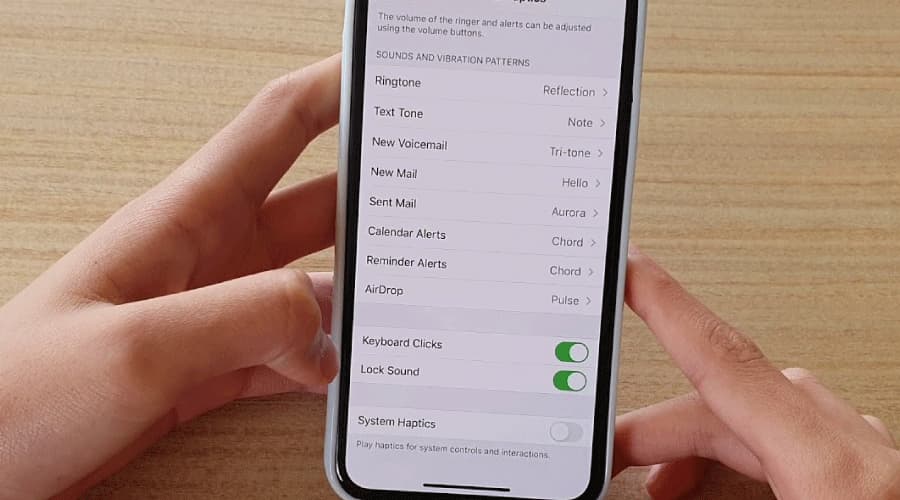System haptics are the vibrations and other feedback you feel when you interact with your iPhone. They help to give you a sense of what’s happening on-screen, and can add realism to the experience of using apps and games. For example, system haptics can make it feel like you’re actually pressing a button when you tap on-screen buttons in an app.

As we’ve seen with the iPhone 11 and 11 Pro, Apple’s haptic feedback system has come a long way. With the iPhone 12, they’ve taken it to the next level. System Haptics are now more realistic and responsive than ever before.
So what exactly are they? In short, System Haptics are the vibrations that you feel when you interact with your iPhone 12. Every time you perform an action – whether it’s opening an app, scrolling through a webpage or typing on the keyboard – you’ll feel a subtle vibration that gives you feedback about what you’re doing.
This makes using your iPhone 12 much more intuitive and natural. Apple has always been at the forefront of haptic technology, and the iPhone 12 is no exception. With its new Taptic Engine, Apple has created a haptic feedback system that is more realistic and responsive than anything else on the market.
If you’re looking for an iPhone that feels truly alive in your hand, then look no further than the 12!
What is System Haptics on Iphone 13
If you’ve ever used an iPhone, you’re probably familiar with the “taptic” feedback that happens when you perform certain actions. With the release of the iPhone 13, Apple is taking this a step further with a new feature called “System Haptics.” This provides haptic feedback throughout the system, not just in response to specific actions.
So what does this mean for users? Basically, it means that your iPhone will now provide subtle vibrations in response to various interactions. For example, if you receive a notification or open an app, you’ll feel a light vibration.
This is designed to give users a more immersive and tactile experience on their devices. Some people are concerned that this new feature will be too intrusive or annoying. However, it’s actually quite subtle and can be turned off if desired.
Overall, we think System Haptics is a cool addition to the iPhone 13 that will improve the user experience for many people.
What is System Haptics on Iphone 11
System Haptics is a new feature on the iPhone 11 that provides haptic feedback when you interact with the phone. It’s similar to the Taptic Engine on the Apple Watch, but it’s been updated for the iPhone 11. System Haptics provides a more realistic and immersive experience when using your iPhone.
For example, when you scroll through a list or open an app, you’ll feel a subtle vibration that simulates the sensation of touching a physical object. System Haptics is designed to work with all of the iPhone’s built-in apps and features. So far, it’s been well-received by reviewers and users alike.
Many people say that it makes using their iPhone feel more natural and intuitive. If you’re looking for a way to improve your iPhone experience, System Haptics is definitely worth checking out!
Should System Haptics Be on Or off
If you’re not sure what haptic feedback is, it’s the vibrating sensation your iPhone gives you when you do something like press a button or type on the keyboard. It’s a way to provide tactile feedback so that you know your actions are being registered by the phone. There are two schools of thought when it comes to system haptics: some people think they’re essential and can’t live without them, while others find them annoying and prefer to turn them off.
So which camp are you in? Let’s take a closer look at the pros and cons of each position. PROS OF SYSTEM HAPTICS
1. They provide valuable feedback. As we mentioned, haptic feedback lets you know that your actions are being registered by the phone. This can be especially helpful if you’re doing something like typing on a virtual keyboard where there’s no physical feedback otherwise.
2. They can be used sparingly for a more subtle effect . If you find constant vibration annoying, most apps allow you to customize how often or how intensely they give haptic feedback. For example, in Messages you can choose to only have haptic feedback when sending a new message or when replying to one .
This way you still get the benefits of haptic feedback without it being too obtrusive .
CONS OF SYSTEM HAPTICS 1 .
They can be distracting . Whether it’s because they’re too frequent or too intense, system haptics can end up becoming more of a nuisance than anything else . This is especially true if you’re trying to focus on something else and keep getting interrupted by vibrations .
System Haptics Sounds
System haptics are the system-level sounds that provide feedback to users in response to their interactions with electronic devices. They can be used to indicate a variety of system states, such as when a key is pressed, when a notification is received, or when an error has occurred. System haptics can also be used to provide tactile feedback, such as when a user scrolls through a list or presses a button.
iOS uses system haptics to enhance the user experience by providing tactile feedback that supplements visual and auditory cues. For example, when you interact with controls or views in iOS, you may feel a light tap or vibration that confirms your action. System haptics are also used on Apple Watch to deliver different kinds of feedback for various interactions.
For example, you may feel a gentle tap on your wrist when you receive a notification, or a more pronounced vibration when you start an exercise routine. System haptics can help people who are blind or have low vision to understand what’s happening on their device without having to rely solely on audio cues. They can also be useful for people who are deaf or hard of hearing, as they provide another way to receive information about what’s happening on their device.
System Haptics Iphone Xr
System Haptics is a new feature on the iPhone X that provides haptic feedback when using various system features. This feedback is meant to provide a more natural and intuitive feel when using the iPhone. System Haptics can be enabled or disabled in the Settings app under General > Accessibility.
When enabled, System Haptics will provide haptic feedback when using 3D Touch, opening Control Center or Notification Center, typing on the keyboard, and other system interactions.

Should System Haptics Be on Or off on Iphone?
There are pros and cons to having system haptics on or off on your iPhone. Here are some things to consider: On the plus side, system haptics can provide helpful feedback when you’re using your iPhone.
For example, if you’re typing a text message and make a mistake, you’ll feel a slight vibration letting you know that you’ve made an error. This can be helpful in avoiding mistakes and helping you stay focused while using your phone. On the downside, some people find system haptics annoying or even distracting.
If you’re someone who doesn’t like constant vibration feedback, then it might be best to turn this feature off. Additionally, some people might find that system haptics interfere with other features on their iPhone such as Touch ID or 3D Touch. So if you’re experiencing any issues with these features, it’s worth turning off system haptics to see if that clears things up.
Ultimately, whether or not to have system haptics on is a personal preference. Consider how much vibrational feedback you want while using your iPhone and adjust accordingly.
What Happens If I Turn off System Haptics on Iphone?
If you turn off system haptics on your iPhone, you will no longer feel haptic feedback when using certain features on your device. This includes features like 3D Touch and Force Touch, as well as tactile feedback when typing on the keyboard or interacting with apps. While some people may prefer to turn off system haptics, others may find it beneficial to keep them enabled.
If you’re not sure which setting is right for you, experiment with both options to see what works best.
What is the Point of Haptics?
Haptics, also known as kinesthetic communication or touch communication, is the use of touching to communicate. It involves the conscious awareness of the body and its surroundings through the sense of touch. Haptics is used in a variety of ways, including: learning about and exploring one’s environment; communicating with others; and expressing emotions.
The haptic sense is important for everyday activities such as eating, drinking, grooming, and walking. Without haptics, we would not be able to interact with our environment in a meaningful way. For example, imagine trying to eat without being able to feel your food.
You would not be able to tell if it was hot or cold, how hard or soft it was, or what texture it had. Similarly, you would not be able to tell if you were touching something sharp or smooth without being able to feel it. In addition to its role in everyday activities, haptics is also important for social interactions.
Touching is often used as a way to express emotions such as happiness, sadness, love, anger, fear, and disgust. It can also be used as a way to communicate non-verbally with others. For example, hugging someone can show comfort and support even when no words are spoken.
Overall, haptics plays an important role in both everyday activities and social interactions. It allows us to interact with our environment in a meaningful way and express ourselves non-verbally to others.
Does System Haptics Drain Battery?
In short, yes. System haptics, which include features like 3D Touch and Taptic Engine feedback on the iPhone, do use battery power. However, they are a relatively small drain on your battery compared to other features and activities.
Here’s a bit more information on how system haptics work and why they use battery power.System haptics use what’s called a linear actuator to create vibrations. This is basically a small motor that moves back-and-forth very quickly to create vibration. When you press down on the screen with 3D Touch or get Taptic Engine feedback from an alert or notification, this linear actuator is activated.
All of this movement takes energy, which means it uses up some of your battery power. However, because system haptics are such brief events, they don’t use up a lot of power overall. In fact, Apple says that system haptics only use a fraction of 1 percent” of your total iPhone battery capacity each day.
So while system haptics do drain your battery ever so slightly, it’s not enough to make any real difference in your day-to-day usage. If you’re looking to save every last drop of battery life, you can always disable these features in Settings -> General -> Accessibility -> Reduce Motion -> turn off “Reduce Motion. But for most people, leaving system haptics enabled won’t have any noticeable impact on their iPhone’s battery life whatsoever.
Conclusion
Haptics are the use of touch to communicate with users and provide feedback. The iPhone 12 features a new haptic feedback system called “Taptic Engine” which provides more realistic and nuanced haptic feedback than previous iPhones. This includes different types of vibration patterns for different types of interactions, as well as pressure-sensitive buttons that give haptic feedback when pressed.





